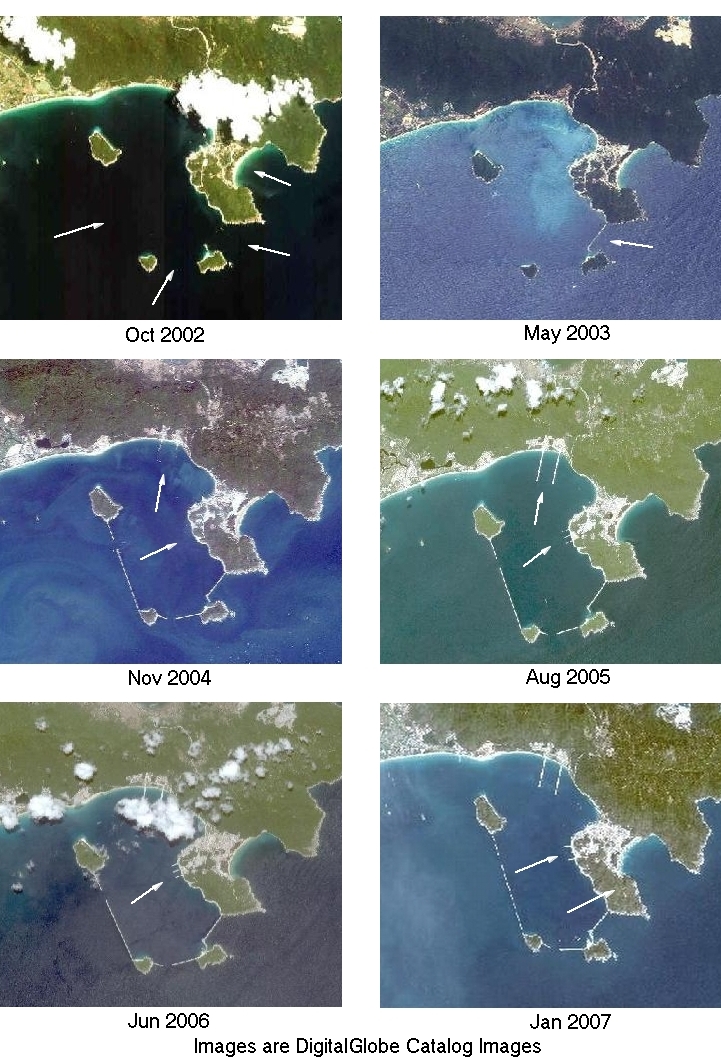According to the Dept of Defense photographic intelligence consists of collecting products of photographic interpretation, classified and evaluated for intelligence use. Also called PHOTINT.
Curious soul that I am, I thought I would give it a try. My analysis is non-classified, but interesting.

Development in Ya Long Bay and at Ya Long Naval Base (2002-2007)
Lang-yeh Wan (Ya Long Bay) contains several islands and islets. Dongmao Zhou (18°11'N., 109°41'E.), 111m high, is the outermost island of the bay. A 14m high rock and an 11m high rock lie close E and N, respectively of the island. Hsi Chou, 105m high, lies 1 mile W of Dongmao Zhou and is marked on its SE end by a light.
Yeh-Chu Tao, an island, 95m high, stands within the bay about 2.5 miles NW of Dongmao Zhou. Two small islets, Tung-p'a and Hsi-p'ai lie to the W of Yeh-chu Tao. Anchorage can be taken in 12.8 to 14.6m, mud and sand, about 0.8 mile NE of the E end of Yeh-chu Tao. However, the NE wind blows strongly between the hills of the peninsula to the E and during S and SE winds, considerable swell may build up in the bay.
Between Pai-hu Chiao and Jinmu Jiao (Chin-mu Chiao) (18°10'N., 109°33'E.), 2.8 miles WSW, the coast is bold and steep-to. This headland marks, at Jinmu Jiao, both the S point of Hainan Dao and for descriptive purposes, the dividing line between the E and W coasts of the island. The peninsula rises to 380m to the NE of the signal station above Jinmu Jiao. A light is shown from the S extremity of this point and the coast to the W is steep-to and bold; a racon is situated at the light. (SD Pub-161; pg 66)
------------------------------
The imagery used in this exercise comes from DigitalGlobe (DG) catalog images found in Google Earth (GE). I selected the above nine images based on four factors: 1) Area of coverage, 2) Date, 3) Cloud-free and 4) Suitable Environmental Quality index (highest for the year). All of the images featured my area of interest, the islands and peninsula where the naval base is located. I had already mapped the area using both Landsat and DG imagery in GE. I identified the naval base from the numerous tags placed by GE naval snoops. They are able to easily identify ships and naval infrastructure using DG's hi-res images. So, back to our PHOTINT exercise.
The Jun 2006 DG image is the one found in GE. I did the overwhelming majority of my mapping of this area using it as my base image and supplemented with Landsat and the DG catalog images to complete my project. After assembling the above date-ordered sequence of images and we can begin the PHOTINT of our area of interest.
Oct 2002 - No protective breakwaters built yet. The site of the naval base is undergoing development, but the small islands scattered about the bay remain unattached.
May 2003 - A breakwater connecting the peninsula and the three southern islands has been built. Not too much other development has happened.
Nov 2004 - What a difference! All of the breakwaters are in place between the islands. The two lengthy piers, from the northern shore, are being built. Still no piers at the naval base proper.
Aug 2005 - All of the piers have been built. The two northern ones and three smaller ones at the base.
Jun 2006 - This is the DG image found in GE. The clouds obscure the two long piers. However, using the other images from previous years, I was able to map them successfully.
Jan 2007 - What happened to the middle pier? Maybe they needed more space between the two outer piers. A final observation concerns the peninsula itself. Apparently, submarines are kept beneath the peninsula. It is riddled with tunnels, some big enough for a submarine (based on GE naval snoops descriptions).
Now, wasn't that interesting? Using a little imagination, creativity, organization, ingenuity and PHOTINT skills, we all learned about the development of a portion of the Ya Long Naval Base. Imagine what the professional intel snoops are able to glean from the real hi-res images?
Enjoy!
PS - If it appears that I am treating a very sensitive and serious subject lightly, that is not my intent. All of us curious sorts that spend hours poring over DG imagery in GE conduct our own PHOTINT. We find aircraft, ships, vehicles, military sites and much more because it interests us. Perhaps in our youth, we too were snoops.
No comments:
Post a Comment